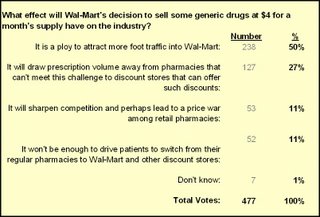Secondary drug wholesalers are planning to file an injunction against the FDA to stop implementation of the Prescription Drug Marketing Act (PDMA) according to this story from Drug Industry Daily. See Drug Wholesalers Seeking Injunction to Stop Drug Tracking Program.
By way of background, the FDA lifted the stay on implementation for the PDMA in June. It is now scheduled to be implemented on December 1, 2006. See my blog posts in the Pedigree category for more background on the issue as well as the FDA's Draft Compliance Policy.
I suppose that this filing was inevitable because the PDMA's Authorized Distributor of Record (ADR) system creates a powerful market dynamic toward a one-step channel. The extra costs and burdens of a two-or-more step (non-ADR) channel have the potential to shift volume among wholesale market participants. Speculatively, I imagine at least three possible outcomes from the PDMA:
- Wholesalers with an ADR relationship will pick up volume. The large wholesalers (MCK, CAH, ABC) will pick up volume from secondary drug wholesalers as well as physician distributors. Many med-surg distributors have found themselves caught between an ADR and a hard place. These companies often stock pharmaceuticals as a convenience for their physician customers but have relatively small volumes of Rx product in their mix (maybe 5% to 10% of total sales). They are not primarily secondary drug wholesalers, so need to either be ADRs or receive pedigree from a major wholesaler. For example, PSS World Medical issued a press release announcing its intent to buy directly from manufacturers after HB371 passed in Florida. (See PSS' Press Release.)
- Manufacturers will broaden their ADR networks. Contrary to popular belief, most pharma companies have authorized distributors beyond the big 3. The top eight manufacturers average of 79 ADRs according to published lists that I reviewed over the summer.
- The marketplace will create a solution for pedigree. A third option would be to allow the marketplace to determine winners and losers. If customers truly demand to purchase from a secondary wholesaler, then we can expect manufacturers to require ADRs to service those wholesalers. A manufacturer could even compensate an ADR for fulfillment to secondary distributors, making ADRs into de facto master wholesalers and possibly creating another area of fee-for-service compensation for wholesalers.
Unfortunately, I have heard only limited understanding of the ADR issue in my conversations with trade relations executives at pharma companies. The FDA is apparently issuing a Q&A next week to clarify the situation. In the meantime, the filing of this injunction should serve as a channel strategy wake-up call to manufacturers that have so far ignored the December 1 PDMA implementation deadline.
----
I have to go and get ready for trick-or-treating. I'm dressing up as something very scary -- a cute, cuddly teddy bear filled with counterfeit drugs! (See Items 7 and 10.) My kids are dressing up as RFID tags. Happy Halloween!

